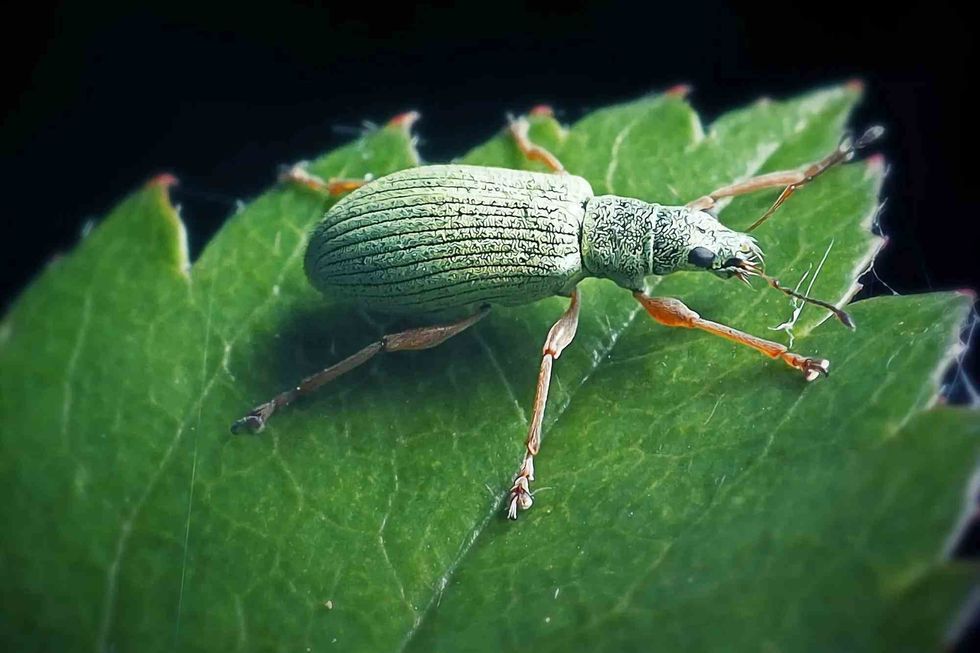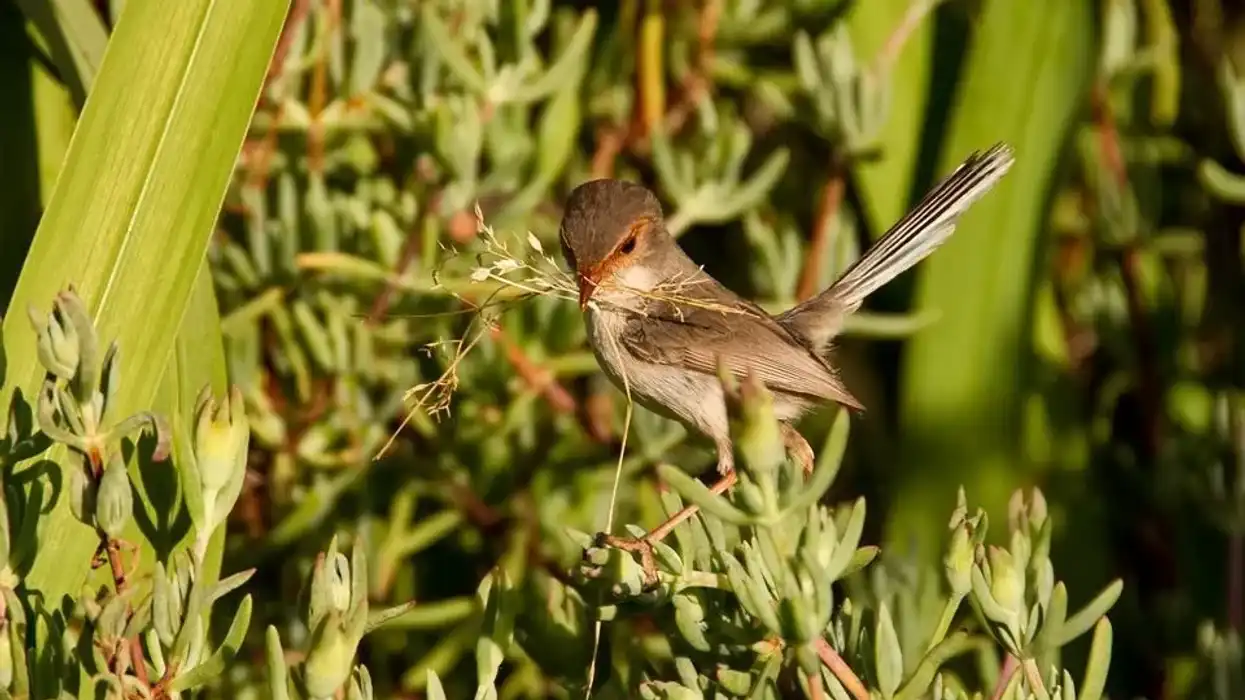In this article, we will learn about the pale green weevil (Polydrusus impressifrons). It belongs to the genus Polydrusus, phylum Arthropoda, and the family Curculionidae.
This weevil is named after its vibrant green body which is covered with green scales. It is also known by the name 'leaf weevil' due to its habit of feeding on leaves.
Polydrusus impressiforns have large heads which appear to be flattened. Their dark black eyes are in stark contrast to their green body.
Their antennae are slightly bent and a small black line is present at its base. This insect was originally found in Europe but made its way into North America in the 1900s. This insect was first found in New York in North America.
These insects are considered to be pests in many regions due to the fact that they feed on the leaves and branches of various plants and trees. However, they can cause harm to the trees if they are very young and don't have enough branches or leaves.
They are mostly found during the spring and early summer season so the damage caused, if any, is minimal. Keep reading to find out more about these fascinating insects.
If you find this interesting and want to gain more knowledge about intriguing insects, be sure to check out boll weevil and weevil beetle.
Green Weevil Interesting Facts
What type of animal is a green weevil?
Green weevil is a type of insect. It is a part of the order Coleoptera.
What class of animal does a green weevil belong to?
Green weevil belongs to class Insecta and the family Curculionidae.
How many green weevils are there in the world?
Since these insects are so small in size, it is difficult to know the total number in the world.
Where does a green seevil live?
Pale green weevil (Polydrusus impressifrons) was transported to North America from Europe in the 1900s. This species belongs to a group that is known to have the ability to contain other destructive species.
What is a green weevils' habitat?
The pale green weevil (Polydrusus impressifrons) can be found all across North America in residential trees and various crops during spring and summer.
Who do green weevils live with?
It is not exactly known who these weevils live with. The members of the order Coleoptera can be found leading solitary lives and sometimes can also be located living in aggregations.
How long does a green weevil live?
The longevity of Polydrusus impressifrons is not known. However, green weevils adults can mostly live up to two or three months.
How do they reproduce?
More research needs to be conducted to find out about the reproduction of the pale green weevil. Most weevils, will either bore a hole in the plant or lay their eggs beside the host plant. Female weevils are known to lay a large number of eggs.
The female weevil can lay up to 250 eggs at once. The larvae or the grubs do not have any legs. After the larval stage, they reach the pupal stage, which lasts for about three weeks.
What is their conservation status?
The pale green weevil (Polydrusus impressifrons) is currently Not Listed in the Red List of the International Union for Conservation of Nature or the IUCN. So, it can be assumed that their population is not at stake.
Green Weevil Fun Facts
What do green weevils look like?
As suggested by their name, the green weevil is completely covered with pale green or, at times, yellowish scales. Their face is long and appears to be flattened. It also has small eyes that are positioned parallel and laterally to its midline. Polydrusus impressifrons also has black lines in its elytra, which are not well defined.
How cute are they?
These weevils are very tiny. Though their iridescent green color (like a green scarab beetle) can make them seem appealing, they are treated as pests and are disliked by most people.
How do they communicate?
Weevils like the pale green weevil usually communicate with other adult green weevils or green weevil larvae by making squeaking sounds.
How big is a green weevil?
Adult green weevils are extremely tiny and have a length of about 0.3 in (0.7 cm). This weevil is about five times smaller than the rhinoceros beetle and slightly smaller than an average ten lined June beetle.
How fast can a green weevil move?
More research needs to be conducted to calculate the speed of a pale green leaf weevil.
How much does a green weevil weigh?
The weight of the green weevil is not known. Studies need to be conducted to calculate the total weight of this insect.
What are the male and female names of the species?
There are no unique names that are used to refer to the male and the female green weevil.
What would you call a baby green weevil?
A baby green weevil can be known as a 'grub', 'larvae' or 'pupa' according to the life stage that they are in currently before transforming into adults.
What do they eat?
Adults of pale weevils are known to chew on the leaves of plants such as maple, birch, strawberry, willow, and more. They most commonly feed on poplar and orchards trees like the cherry, peach, apple, and plum trees.
Adults only eat during the spring and early summer. The green weevil grubs or larvae feed on the stems or small roots of the host plant.
Are they harmful?
Just like lace bugs, pale green weevils are not at all harmful to humans. However, adults, as well as the larvae, feed on young leaves as well as the small stems and shrubs of many plants and trees like the birch, apple, cherry, strawberry, and peach.
Due to their eating habits, they are considered a pest of many different fruit trees.
Would they make a good pet?
No, the green weevil is not traditionally kept as a pet and would not make a good pet companion.
Did you know...
Contrary to popular belief, most leaf weevils do not cause any harm to the trees or plants that they feed on. These insects tend to leave jagged edges on the leaf after chewing them.
Mature trees with abundant leaves and branches will not be damaged by the adult weevils or their larvae. However, the young plants might get a little damaged and an annual inspection must be conducted to keep them off.
This green weevil beetle was first documented in North America in the city of New York in the year 1906.
The pale green leaf is not to be confused with the green immigrant leaf weevil which belongs to the same family and has metallic green scales.
Naming the green weevil
The pale green weevil is named after its green-colored body. It is also known by the name leaf weevil, due to the fact that it feeds on various types of leaf.
Do green weevils have eyes?
Yes, this insect does have eyes. However, how many eyes they have is unclear. The adult weevil's eyes are large in size and black in color. Their black eyes along with a small black line at the base of their bent antennae are distinctly noticeable on their long, green heads.
Here at Kidadl, we have carefully created lots of interesting family friendly animal facts for everyone to discover! For more relatable content, check out these bloody nosed beetle facts and ambush bug facts pages.
You can even occupy yourself at home by coloring in one of our free printable I for insect coloring pages.









